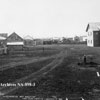Barr Colony: The Origins of Lloydminster (1903-1914)

Prior to the 20 th century, there was no Lloydminster townsite and hardly any human settlement in the area where the future town would develop. Trees were scarce while water and food were in short supply, making it largely unattractive to settlers. The land was surveyed and townships staked in 1883.
If it had not been for Reverend Isaac Montgomery Barr, Lloydminster might have remained a desolate location for quite some time. In 1902, Barr, an Anglican reverend from England, visited the area and reserved 16 townships for his Barr Settlement. The Canadian National Railway was also surveying the area, as it was on a direct route from North Battleford, Saskatchewan to Edmonton. Barr developed a pamphlet to advertise settlement in Canada’s Northwest Territories. At the same time, Reverend George Lloyd was recommending settlement in Canada. Barr and Lloyd teamed up, and Lloyd was hired on as chaplain for the group. Settlers were quickly gathered. Barr envisioned a colony of 500 but he received responses from over 3000 willing settlers. In the end, 2000 settlers arrived by May of 903, traveling from Saskatoon to their new home, the future Lloydminster. The Barr Colony was born.

Barr Colony, however, would not keep its name for long. Many of the settlers were unprepared for the challenges of living in the wilderness of Alberta and Barr was soon resented for offering false promises. The settlers lost confidence in his leadership, turning to Reverend Lloyd for guidance. They wanted to name their colony after him; thus the new town was named Lloydminster (a “minster” refers to a mother church). In November of 1903, the settlement was officially incorporated as the Village of Lloydminster.
Many of the original colonists were disillusioned by their colonial life, so quite a few returned home. In 1906, Lloydminster’s population was only 519. Despite Lloydminster’s setbacks, the settlement was poised to grow, largely because of the plans for a Canadian Northern rail line arriving from Saskatchewan. The line reached Lloydminster in August of 1905. Overnight, Lloydminster’s property values skyrocketed from three or four dollars an acre to about 20 dollars an acre.

By 1903, Lloydminster already had two large general stores, a post office, a drugstore, and saddlery, a carpenter, three restaurants, a livery stable and 75 houses. The very next year, a branch of the Canadian Bank of Commerce became the village’s first bank. Two more banks followed on its heels. In 1904 Lloydminster received its first hotel, the King Edward Hotel. The next year, Lloydminster had two more hotels – the Brittania and the Alberta. By 1905, there were 100 houses with many more to come because railway speculation made the settlement attractive to investors and settlers. Also, the original Barr settlers were encouraging their relatives to settle in the area. For example, the Thompson-Hutchinson immigration party of 150 settlers came from England in 1905 to take up homesteads around the area.
1905 proved to be an eventful year for Lloydminster. That year, Alberta and Saskatchewan were designated provinces. The division between the two provinces was to be the fourth meridian. Unfortunately, the fourth meridian bisected Lloydminster, and although the community petitioned the Federal Government to move the line around Lloydminster, the government refused and Lloydminster was split in half. On the Saskatchewan side of the border was the Town of Lloydminster; on the Alberta side, a village. Each community would have its own municipal government, utilities, and school district. The town and village were not to be officially amalgamated until 1930.

By 1906, the Town of Lloydminster was in a building boom with new frame and brick buildings going up. It now had a brickyard, three lumber yards, two hardware stores, five general stores, three hotels, a bank, a general hospital and a public school.
Lloydminster had a unique healthcare system stemming from Isaac Barr’s “medical co-operative” in which families would pay fees to join the co-op and thus receive basic hospital care. However, the doctors that were supposed to come to the colony did not, so the nurses had to attend the colonists, and they had no hospital, until they set up their own field hospital. A nurse, Mabel Drewe, set up a private hospital in 1904. A community hospital was not built until 1908, and then a new and better hospital was built in 1917.

As for religious services, the first church in Lloydminster was, as might be expected, an Anglican church. Reverend Lloyd held services at his home, until the first log church was built in 1904, St. John’s Minster. A new St. John’s Minster was built in 1910. There was a Baptist Church in 1904 for a short period of time until it was forced to close due to insufficient membership. Presbyterians held their services at the Immigration Hall until Knox Presbyterian church was built in 1911. Lloydminster also became home to a Wesleyan Church (1906) and a Catholic church (1910).
St. John’s Minster also served as Lloydminster’s first school, until 1906, when a permanent two-room school house was erected. Because of the division of Lloydminster, the school of 35 students operated under two separate school districts, one for Saskatchewan students and one for Alberta students. In 1912, a four room brick school was built to serve primarily has a high school.
At the dawn of the First World War, Lloydminster was still a small community. Technically, it was two small communities, with about 250 settlers in the village and almost 500 settlers in the town.
References
Foster, Franklin Lloyd and Alan Grant Griffith. Bordering on Greatness: A History of Lloydminster’s First Century 1903-2003. Lloydminster: Foster Learning Inc., 2001.
“ Lloydminster: From Oxcart to Oilwell, 1903-1950.” Lloydminster High School Essay Club, 1950.
McCormick, J. Hanna. Lloydminster: or 3,000 miles with the Barr Colonists. London: Drane’s Press, 1924.



